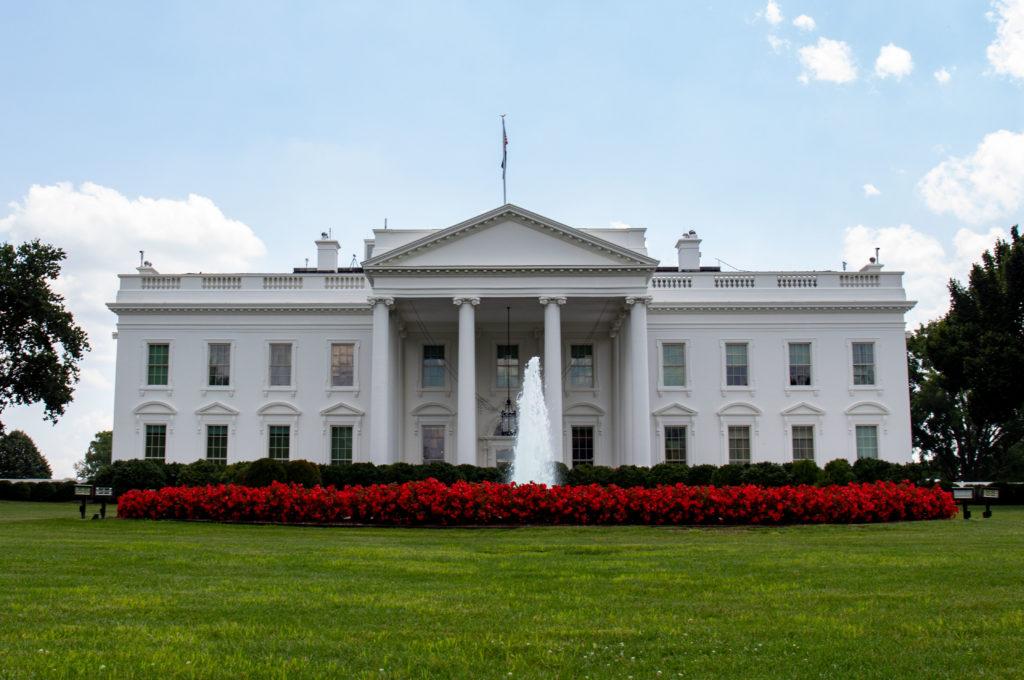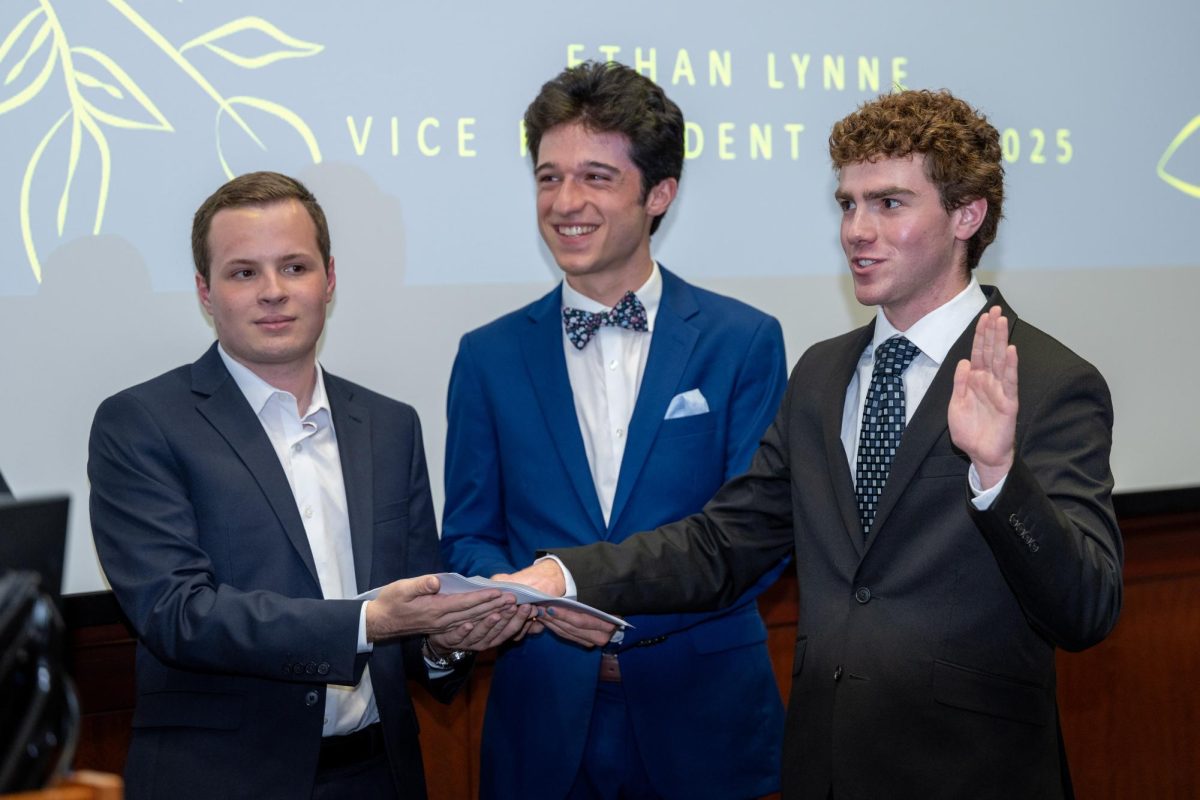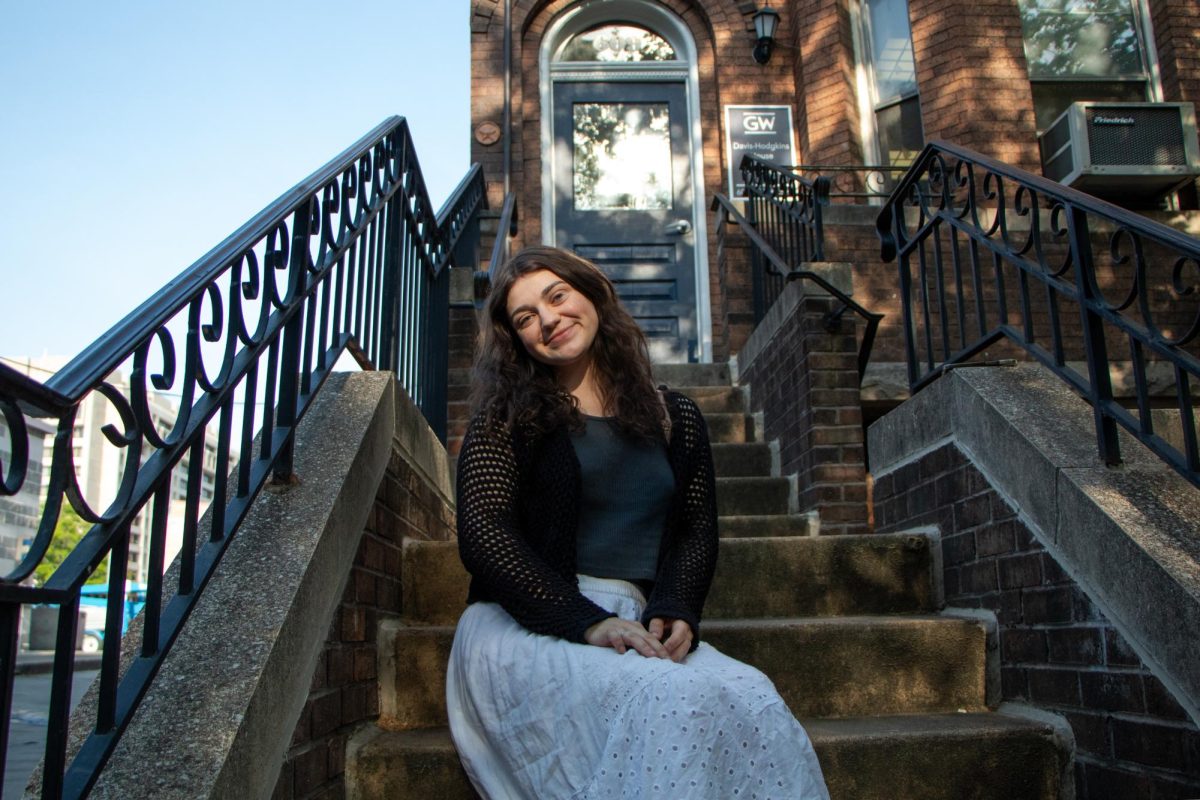Updated: Saturday, April 5 at 7:18 p.m.
Fastened by heart-shaped stickers, a handmade sign at the top of a Mount Vernon Campus residence hall room door declares that students have formed a “West Hall family.”
The decoration at the entrance of the second-floor room, where 19-year-old Benjamin Asma was found unconscious Tuesday after an apparent suicide attempt, is the kind of message that has reverberated across GW this week on campuses stunned by a pair of deaths just hours apart.
As students look to cope with the losses of Asma and senior Lynley Redwood, they have found support across campus. Reminders for students to seek help, give hugs and call home have cascaded after the third tragedy to strike GW in about three months.
To expand counseling services, GW has tapped faculty from the medical school and psychology departments in addition to hiring outside help, and will keep counselors on the Mount Vernon Campus through the end of the school year.
Professors canceled their lesson plans to create spaces for students to just talk. Admissions tour groups have stayed away from West Hall to give residents more privacy. Groups of floormates stayed in on Friday night to cook dinner and watch movies. Dozens of students have spread uplifting messages online.
“We came to this University to be a part of something extraordinary, and we have to stick together in that. To all of my GW family, please don’t go at this alone,” sophomore Taina Diaz-Reyes said in a YouTube video that collected 400 views within a few hours Friday night.
In a letter to parents that was emailed Friday, University President Steven Knapp shared his own grief and stressed that GW had a broad system of support for students across campuses.
“In my twenty years in the administrations of two universities, I have from time to time had the very sad duty of meeting with a student’s grieving family and friends, but I have never before experienced two such tragedies in a single week,” he wrote.
The pair of deaths shocked a University that had just mourned the death of freshman Sean Keefer in January. All three students were residents of West Hall, and both Asma’s and Keefer’s deaths have been labeled as suicides. Redwood’s death is not being investigated as a homicide, but neither police nor D.C.’s medical examiner have yet confirmed a cause.
For the communities most affected, the last several days have been filled with heartbreak and struggles of understanding. Friends stood shoulder to shoulder with family members Thursday at a candle-lit service, where Asma’s parents asked students to be strong and look out for others in distress. Counseling center staff have spent hours visiting communities such as the University Honors Program and the Beta Theta Pi fraternity, while counselors have met with West Hall residents both one-on-one and in small groups.
TJ Brown, a sophomore who had steered Asma through their fraternity’s new member process, said his death has been difficult for the chapter, but has brought them together.
“Every time I turn a corner, there’s a brother who will give me a hug and ask me how I’m doing,” Brown said.

Balancing the outreach
Administrators and department leaders have been cautious with their communication to students potentially impacted by the recent deaths.
Michael King, chair of the chemistry department, said he has reached out to some of Redwood’s lab partners and other professors have spoken with her classmates. But he said some of his colleagues believe that the outreach is not necessarily appropriate across the University “because there are a lot of feelings involved.”
“We have been engaging the students who were in classes with Lynley in conversations and providing them with opportunities to share their feelings, but I don’t want to impose the idea that that is something for the entire community at this moment,” King said.
GW has mobilized mental health resources across the University, charging faculty in GW’s public health and medical schools to provide for students, if needed. The office of parents services has also answered calls and emails over the weekend, while Mount Vernon Campus house staff have added extra meetings with students.
The University is also relying on resources from outside mental health services, Dean of Student Affairs Peter Konwerski said Saturday.
“We are not going to spare any resource,” Konwerski said.
Universities’ responses to student deaths, particularly suicides, is part of a complex balancing act, experts say. Administrators must watch out for students who are directly affected as well as at-risk students across a university, without overwhelming others in the community.
Campus-wide memorial services, announcements and outreach from the counseling center must be coordinated sensitively to avoid raising the levels of anxiety, said Victor Schwartz, the medical director for the Jed Foundation, a New York-based nonprofit that advocates for suicide prevention at universities.
There’s more pressure when a college has evidence of a suicide cluster – three or more incidents in one location within a few weeks or months.
Schwartz said clusters are extremely rare, but are more common among young people between the ages of 14 and 25. He added that there is little understanding within the medical community of what can cause them but said students who die in these clusters, like all instances of suicide, are nearly always facing a range of psychological problems.
“The trend is, in a sense, the unpredictability. There’s no obvious reason why [suicide clusters] happen at a particular time. They will typically stop just as mysteriously as they start,” he said.
Universities should also try to build a complete picture of the incidents before determining whether it should address a wider campus issue, said Alan Berman, the executive director of the American Association of Suicidology.
“It may be premature and ineffective to jump in and do something without knowing as much as you can,” Berman said. But he said University staff must stay closely attuned to the emotional responses of his acquaintances and friends, who will be “at increased risk for some time.”
GW’s mental health history

A decade ago this month, the campus was hit by another string of student deaths: Three students had committed suicide within four months and seven died within nine months, prompting a months-long investigation by 21 administrators and staff members.
The sweeping 55-page report, released in September 2004, called for expanded budgets, staff, hours and training at the University Counseling Center.
Then-University President Stephen Joel Trachtenberg said Friday that calling the parents of those deceased students were some of the toughest moments of his presidency. After the report, he helped implement many of the report’s recommendations, but said Friday that no university can find a true solution to far-ranging problems like suicide.
“We live in a contingent universe and we’d like to think we have more control than we do,” Trachtenberg said. “This in no way means we shouldn’t try harder and shouldn’t try to figure it out. But there’s a lot of stuff that’s outside of your control despite your best efforts.”
About a month after Keefer took his life in January, the director of the University Counseling Center announced that he planned to ask the University to set aside money to hire a suicide prevention specialist. He also said he planned to expand training for faculty and staff by paying for online tutorials.

UCC has pushed out messaging this week about where students can receive help and has added three hours of counseling each day on the Mount Vernon Campus, which does not have its own health offices.
Two groups of students have also formed their own mental health networks this week. A third started holding meetings at the end of last month.
GW Advocates, which is looking to document students’ concerns in a report to top administrators, is planning a long-term campaign to press GW to reform its mental health resources. Another organization, GW Unites, plans to create a student-run support network.
Concerns of an underfunded and understaffed counseling center have recently resurfaced.
Silvio Weisner, the counseling center director, said earlier this year that his 18-person staff has been stretched to meet the rising demand of students. To accommodate more students, he has increased group counseling, reevaluated the office’s walk-in structure and increased the number of doctors in its referral network. GW also announced last month that it would move the K Street counseling center, as well as the health center, to the Marvin Center in the heart of the Foggy Bottom Campus.
To help prevent students from falling through the cracks, GW also launched a mental health referral system called CARE Network two years ago, in which students and employees can submit names of individuals who may need extra support.
About a year after the system was launched, about 275 students had been reported but dozens of professors surveyed by The Hatchet said they had little or no knowledge of the system.
Konwerski said he had noticed anecdotally that the number of students reported through the CARE Network has increased after each of the recent student deaths. He said GW will continue educating students and faculty of the system, which became used by many universities nationally after tragedies like the Virginia Tech shootings in 2007.
The University has also had to fight off the impression that students could be expelled for seeking treatment, partly stemming from a 2006 lawsuit by former student Jordan Nott, who alleged that he was barred from campus for reporting suicidal thoughts.
Administrators said then that Nott, whose close friend had committed suicide in 2004, could potentially be a danger to himself or others. The case was settled out of court on terms of confidentiality.
Earlier this year, a student said she was told three years ago she would be expelled from the University months after attempting to commit suicide because she wanted to stop her UCC sessions and start receiving outside help. She ultimately transferred before returning to GW for her final year.
University spokeswoman Candace Smith reiterated on Saturday that “there is no university policy that threatens students who may be seeking to harm themselves with expulsion from the university.”

A shattered calm
The community that has been hit the hardest is the Mount Vernon Campus. The 23-acre suburban campus, with grassy hills, historic brick buildings and freshly updated tennis courts, offers a quiet respite from Foggy Bottom. But as West Hall, the campus’ largest residence hall, lost its third student this semester, the calm has been shattered.
West Hall, which is quiet enough that it does not have security officers at its front desk, is home to about 280 freshmen and upperclassmen. With communal kitchens and common rooms on every floor, students – freshmen in particular – frequently leave their doors open as they pass through each other’s rooms to study, cook together and watch TV.
For the last three days, several first floor rooms have served as makeshift counseling center offices for West Hall students. The University also added additional counseling hours at Eckles Library this weekend.
Jessica Ryabin, a freshman who lived in Somers Hall and was Asma’s close friend through the club swimming team, said he was constantly surrounded by his friends in his building. “I know that he was very close with everyone who lived around him,” she said.
At a student-organized vigil on the Marvin Center terrace Thursday night, friends of Redwood and Asma walked one by one to the microphone to share stories of Redwood’s unbending friendship or Asma’s “contagious smile.”
When Asma’s parents, Benjamin and Leann, stepped to the microphone, they said hearing their son’s friends share those kinds of memories was therapeutic.
“You guys are helping the healing process and helping us understand the environment he’s been in, and it’s beautiful,” Asma’s father said.
– Chloe Sorvino and Brianna Gurciullo contributed to this report.








